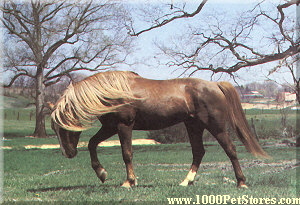The Spanish conquistadores and other explorers of the American south-west took horses with them. Those which escaped formed bands, and became known as mustangs, from a Spanish word for 'ownerless animals'. No particular conformation marked mustangs, although they usually stood under 15.2hh (158cm) and were sturdy enough to stand the rigours of range life. With few natural predators, bands flourished until there were millions of wild horses roaming the Great Plains from Mexico to Canada.
The mustang population was severly threatened by settlers. Hundreds of thousands of wild horses were rounded up for use in the Boer War and World War I, and more were slaughtered for pet food, fertilizer or leather. The remaining horses were driven westwards into the Rocky Mountains. From an estimated two million wild horses at the turn of the century, fewer than 17,000 remained in the late 1960s.
Public reaction to the slaughter was roused by such people as Velma 'Wild Horse Annie' Johnston and Hope Ryden, amid much press and television publicity. Congress was moved to action, and in December, 1971, harassment or slaughter of wild horses was made a federal crime. In spite of this mustangs continue to be hunted, and most recent estimates number them at fewer than 10,000.
MUSTANG

www.cowboyhorses.com/breeds/spanish_mustang.html
www.horsequest.com/breeds/mustang.html#xbreeder
www.ttsd.k12.or.us/district/curriculum/elem/extrasci/mustang.html
www.equiworld.net/uk/horsecare/Breeds/kigermustang/index.htm
www.chaffee.net/~steague/bitowy.html Mustangs of Colorado
www.horseweb.com/links/Breeds_Breeders/Mustangs_Wild_Horses/index.htm Great links!
www.horsenet.org/horsebreeds/mustang.htm